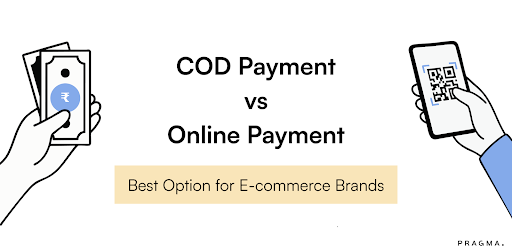A Playbook For D2C Brands To Tackle RTO, Drive Growth
Preparing for the holiday shipping season? Yeah, that’s why we decided to step in and say that this project might require a pretty good logistics strategy. One that enables quick, timely, consistent, and reliable delivery for fulfilment.
But what’s the problem we face during this Holiday season? Well, keeping up with a great volume of orders would be on the top of that list. Which could be quite challenging; Without the right logistics assistance that is.
Luckily, you don’t have to look far to tackle the hectic Holidays. To fulfil consumer demand during the busiest retail seasons of the year, Pragma has got it covered in Pragma’s Ecommerce Holiday Journey Guide
To fulfil consumer demand during the busiest retail seasons of the year, Pragma has got it covered in Pragma’s Holiday Playbook.
Pragma is a best-in-class Logistics service provider that can help you prepare for the holiday season. Monitoring inventory, choosing what fulfilment locations to use, and having orders picked, packed, and shipped quickly and economically - How? Check out our Ecommerce Holiday Journey Guide.
Learn how Pragma has partnered with online brands in a diverse range of sectors to prepare for the peak season.
What is Direct to Consumer (D2C)?
Direct-to-Consumer (D2C) refers to a business model where products or services are sold directly to consumers, bypassing traditional retail channels, wholesalers, or distributors.
In this model, brands manufacture or produce their products and then market, sell, and distribute them directly to end customers through various channels such as online platforms, company websites, pop-up shops, or subscription services.
D2C brands typically prioritize building direct relationships with consumers, which allows them to gather valuable data about their customers' preferences, behaviors, and purchasing patterns. This data can then be used to personalize marketing efforts, improve product offerings, and enhance the overall customer experience.
Now, let’s discuss holiday logistics.
Holiday logistics entails an ideal supply chain process, efficient to its core - when it comes to handling high volume orders. Without a proper strategy, it becomes a challenge to accurately pick, package, and dispatch orders quickly and on time.
And preparing an online store for peak season takes extra extra preparation. That’s why many online eCommerce businesses partner with a Logistics Management Provider like Pragma to enable fast order fulfilment, allowing brands to focus on other strategic efforts such as holiday marketing & promotions.
Why D2C Brands Need A Bharat Playbook
Be it Diwali, Black Friday, Thanksgiving, or Christmas, if your online store isn’t ready with the D2C Holiday Ecommerce Essential for a sudden influx of website traffic, customers, orders, and returns, those days can become quite chaotic — and may even result in lost revenue
Sales continue to rise, but the supply chain has become more complex during the Pandemic.
This is why Pragma takes on holiday logistics on your behalf. Helping you optimise your site for the surge of online shoppers, plan marketing and holiday campaigns with the help of Automated WhatsApp promotions, and also emphasise your customer service centre to handle more Inquiries, as well as Returns.
The D2C Playbook
Diwali through Christmas Eve, the time of year when the bulk of eCommerce brands witness the biggest spike in orders.
So, here are a few tips on optimising your system.
1. Predicting market conditions & demand
Using Ecommerce Holiday Forecasting, you can manage stock availability by tracking fast-selling vs. less popular SKUs and arrive at informed decisions on how much of each SKU to replenish and in what quantity.
Looking at historical data, evaluate planned promotions, and determine how you handle big spikes in demand.
This becomes more effective if you have previous years’ data to make decisions as well.
2. Determining inventory numbers
By learning production lead times, you lower the risk of shortages, backorders, and running discounts/deals on out-of-stock goods.
To make sure you have enough inventory to handle demand, be sure to work closely with your supplier by sharing predicted Q4 shipment volume ahead of time to avoid potential stock-outs.
Plan in longer than usual lead times, owing to not only Q4 demand but shipping delays and potential supply chain challenges.
3. Spread inventories out for speedy delivery
By stocking products in multiple locations, you get to lower freight costs and increase conversions by adding free shipping offers and other related incentives.
If you partner with a provider like Pragma, you have access to location data to optimise logistics costs, reduce transit times, etc., based on Geoanalysis data concerning sales in different locations.
Data and analytics & visualisation tools help you understand which regions (cities & countries) to optimise your marketing strategy as well. And loop back to your brands’ ideal product allocation approach.
Enabling you to categorise areas into 2-day, free shipping or other with a minimum spend cap that’s above your Average Order Value. Thereby increasing your AOV by over 90% and decreasing cart abandonment by over 15%.
4. Be aware of seasonal delivery patterns
Especially during this pandemic, it’s critical to plan and track carrier transit times and alert potential delays to your customers.
And as always, be sure to offer your customers ‘Order tracking’, so they can follow orders in real-time.
5. Plan your Returns/Refunds Management process
Establishing your Post-Delivery management strategy properly is key to improving brand loyalty and driving sales by making the returns/refunds process as simple as possible for your customers.
An ideal return experience also encourages customers to make an exchange, so you don’t lose out on a sale.
Check and double-check your returns/refunds/exchange policy in place, and ensure that it is easy to understand, offers an extensive range of options, accessible on your online store/product listings.
6. Invest in a Logistic service provider that vibes with your needs
Meeting holiday demand on your lonesome is pretty challenging, and owning your in-house system for every aspect of your business will be expensive and also time-consuming.
So, the sooner you get started, the simpler it gets.
In a time crunch to get onboarded with a Logistics Management Provider? Pragma provides support to help you get up and running fast, so you’re prepared for the forthcoming holiday season.
Here is an outline of Pragma’s holiday logistics solutions:
- Predicting inventory demand with forecasting tools
- Improving order fulfilment rate
- Fast distribution options
- Inventory monitoring solutions
- Streamlined returns/refunds/exchange management workflow
- Automated customer support
- Geoanalysis for distributing inventory
- End-to-end Order management
- Statistical Reports and Analytics
- End-to-end customer experience - Pre-Purchase to Post-Purchase and Post-Delivery
To Wrap it up
Pragma enhances your overall Order Fulfilment stats and improves Logistic Operations from the inside. Just like a simple Valentine’s day effort refreshes a relationship.
And with the added benefits of
- RTO & Fraud Detection
- Auto NDR Management and
- COD to Prepaid Conversion
You get to experience a through & through smooth, seamless, and loss-free holiday journey.
Enabling you to…
Conserve on Overall costs
Improve Conversion rate
Stock, Deliver, and Scale efficiently, and effortlessly.
In search of a Pro in eCommerce Management and Shop Logistics?
GET IN TOUCH WITH PRAGMA - Click here to get started

FAQs
What is a D2C playbook, and how can it help brands tackle RTO (Return to Origin) and drive growth?
A D2C playbook is a comprehensive guide or strategy document tailored specifically for Direct-to-Consumer brands. It provides a structured approach to addressing challenges such as high RTO rates, which occur when products are returned to the origin due to issues like wrong address, failed delivery, or customer dissatisfaction. By following the strategies outlined in the playbook, D2C brands can minimize RTOs and drive growth by optimizing their operations and improving the customer experience.
How can D2C brands leverage a holiday playbook to reduce RTO and capitalize on seasonal opportunities?
A holiday playbook for D2C brands outlines specific strategies and tactics to navigate the unique challenges and opportunities of the holiday season. This includes optimizing inventory management, enhancing fulfillment processes, offering attractive promotions, and providing exceptional customer service to handle increased demand and mitigate RTO risks during peak shopping periods.
What are some common causes of RTO for D2C brands, and how can they be addressed?
Common causes of RTO for D2C brands include incorrect addresses, failed delivery attempts, damaged or defective products, and customer dissatisfaction. These issues can be addressed by implementing measures such as improving address validation systems, optimizing packaging to prevent damage during transit, enhancing communication with customers throughout the delivery process, and offering flexible return policies.
How can D2C brands optimize their fulfillment processes to minimize RTO and improve operational efficiency?
D2C brands can optimize their fulfillment processes by investing in technology and automation, optimizing warehouse layout and inventory management systems, implementing real-time tracking and monitoring of shipments, and partnering with reliable logistics providers. By streamlining fulfillment operations, brands can reduce RTO rates, improve delivery times, and enhance the overall customer experience.
What role does data analytics play in reducing RTO and driving growth for D2C brands?
Data analytics enables D2C brands to identify patterns and trends related to RTOs, such as common reasons for returns, geographical areas with high return rates, and product categories prone to issues. By analyzing this data, brands can take proactive measures to address root causes of RTO, optimize product offerings, and tailor marketing strategies to maximize growth opportunities.
Talk to our experts for a customised solution that can maximise your sales funnel
Book a demo




.png)